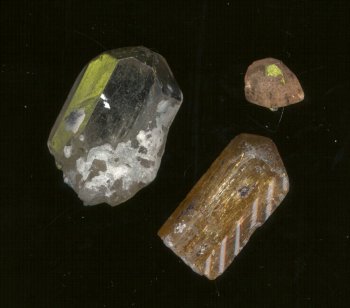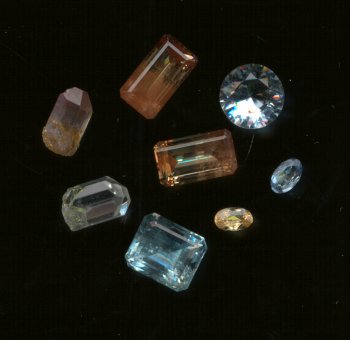Topaz, the birthstone for November, may have derived its name from the Island of Topazios in the Red Sea but some authorities think the name may have come from the Sanskrit word "topas" that means "fire." I personally favor the former explanation as topaz is known for the very soft colors that most finished stones display.
Topaz is an orthorhombic fluosilicate of aluminum and it comes in many colors including pink, blue, lavender, yellow, orange, orange-yellow, brownish yellow, yellow-brown, red, and colorless to mention a few. Topaz crystals may become quite large and finished gems weighing several thousands of carats are seen in many museum collections. Visitors to the 1974 National Gem and Mineral Show in Lincoln, Nebraska saw a 144,000 carats (63 pounds) crystal of golden-brown topaz from Brazil. It was exhibited in a bushel basket.
Topaz has many lower priced imitators that include synthetic corundum and synthetic spinel as well as citrine quartz; the latter often sold under the misleading name of "Brazilian Topaz." More recently, colorless quartz crystals that are coated with a monomolecular layer of gold have been substituted for blue topaz. These stones have been sold under several trade names such as Aqua-AuraTM.
Topaz is fairly hard but its use is somewhat restricted by the perfect basal cleavage along the basal pinacoidal (crystal face that intersects a single crystal axis) crystal face. The facetor must be sure that no facets of a stone are parallel to this face or the faceting machine will simply tear away thin layers of topaz cleavages.
Topaz has a specific gravity of about 3.50 to 3.57. Light shades (pink, yellow, etc.) usually occupy the lower range and darker shades (blues) usually occupy the higher range, as do colorless stones. Many of the blue topazes are derived from colorless stones that have been heat-treated so that is one reason why colorless stones have a higher specific gravity.
The refractive index (the numerical measure of how much the stone bends and slows a beam of light) of topaz ranges from about 1.610 to about 1.617 in colorless and blue to about 1.630 to about 1.637 in yellow and brown stones. The fairly low refractive index and the fairly high specific gravity are an unusual characteristic as refractive index usually varies upward with the specific gravity. The anomalous, low refractive index of topaz may be due to the presence of the very large fluoride ion in the crystal lattice.
Topaz has been found in granitic pegmatite (coarsely crystalline hydrothermal deposits) and in cavities in rhyolitic welded ash flow tuffs. Topaz is almost always found in the form of large, well-developed crystals. Massive topaz is practically unknown. Most gem topaz is mined directly from the host rock or from nearby sediment derived from the host rock. Because of its poor toughness, topaz is rarely found in gravel deposits that have been removed any distance from the source area.
Topaz is usually easily separated from its imitators by refractive index---few materials fall into this range, except tourmaline which is so strongly doubly refractive that one will observe doubled back facets when looking through the table of the stone with a small magnifier (about 6 to 10 power). Topaz rarely comes in the same shades as tourmaline either.
Inclusions in topaz may include actinolite crystals and labyrinth-like fluid-filled hollows that contain materials such as salt water and crude oil as well as various gasses such as Carbon Dioxide. Most gem topaz that reaches the United States has been found in Brazil where it is mined from deeply weathered pegmatites. It is recovered by washing away the silt and clay particles from the weathered host rock and screening for the larger particles. Sri Lanka in the Indian Ocean and the Ural Mountains in Russia were important Old World sources and Scotland and Ireland were lesser sources for these stones. In North America, Mexico has been an important topaz source and California, Colorado, Utah, Maine, and New Hampshire have also produced topaz.

